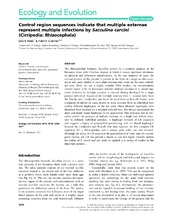| dc.description.abstract | The rhizocephalan barnacle, Sacculina carcini, is a common parasite of the European shore crab, Carcinus maenas, in which it causes significant detrimental physical and behavioral modifications. In the vast majority of cases, the external portion of the parasite is present in the form of a single sac-like externa; in rare cases, double or even triple externae may occur on the same individual host. Here, we use a highly variable DNA marker, the mitochondrial control region (CR), to investigate whether multiple externae in S. carcini represent infection by multiple parasites or asexual cloning developed by a single parasite individual. Sequences for multiple externae from C. maenas hosts from the Danish inlet, Limfjorden, and from the mud flates at Roscoff, France, were compared. In almost all cases, double or triple externae from an individual host yielded different haplotypes. In the few cases where identical haplotypes were identified from externae on a multiple-infected host, this always represented the most commonly found haplotype in the population. This indicates that in Sacculina carcini, the presence of multiple externae on a single host reflects infection by different individual parasites. A haplotype network of CR sequences also suggests a degree of geographical partitioning, with no shared haplotypes between the Limfjorden and Roscoff. Our data represent the first complete CR sequences for a rhizocephalan, and a unique gene order was also revealed. Although the utility of CR sequences for population-level work must be investigated further, the CR has proved a simple to use and highly variable marker for studies of S. carcini and can easily be applied to a variety of studies in this important parasite. | en_US |

